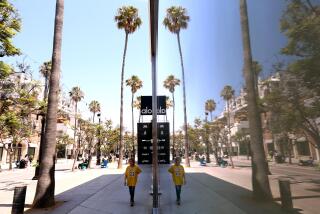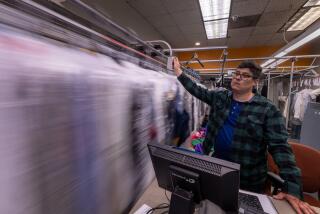Night and Day : Merchants Say Redevelopment Is Answer to After-Hours Crime Problem That Is Plaguing Santa Barbara Plaza : CRENSHAW
The problems plaguing the Santa Barbara Plaza shopping center frequently boil down to the distinct difference between daytime and nighttime traffic, says Karim Ansar, an optician who has operated his business in the plaza for 25 years.
During the day, the sprawling shopping center on 23 acres in the Crenshaw District is home to about 250 businesses--an array of clothing stores, hair salons, cleaners, restaurants, pharmacies and offices for lawyers and doctors. Composed of about 40 buildings surrounding a vast central parking lot, it is the largest concentration of black-owned enterprises in the city.
At night, however, “it becomes a whole new place,” said Ansar, president of the Santa Barbara Plaza Merchants Assn. “The night tenants take over--the thugs, the drug dealers, the winos, the anybodies who don’t want to do anything. They come out and it’s their turn to occupy the property, and we have to leave or risk being mugged.”
The area is troubled by frequent car break-ins, burglaries and robberies. Occasionally, the violence turns especially ugly, such as the time last year when five people were injured, one fatally, after a shootout in a Jamaican restaurant.
Merchants and property owners at Santa Barbara Plaza, across Marlton Avenue from the Baldwin Hills Crenshaw Plaza, an enclosed mall, say the answer to their problems lies in redevelopment, something that has been under consideration for years.
“We would like to see redevelopment done in a timely manner, not dragging it on five or six years,” said Tony Howell, president of the Santa Barbara Plaza’s property owners group.
When the city and the Alexander Haagen Co. pumped $100 million into rebuilding the Baldwin Hills Crenshaw Plaza in 1988, it was widely believed that Santa Barbara Plaza would benefit from an overflow of business.
That hasn’t happened. Baldwin Hills Crenshaw Plaza has itself been struggling to rent retail space and attract customers, even though it is an island of security--surrounded by a seven-foot fence, patrolled by a private security force and monitored by a police substation on the premises.
Some nearby property owners and merchants say that instead of enhancing commercial activity in the surrounding area, the new mall has done the opposite. At Santa Barbara Plaza, Howell said, “Sales have dropped about 50%; businesses are closing up, and we can’t get new tenants to replace them.”
Nearly 200 businesses have dropped off the rolls of the Santa Barbara Merchants Assn. since the renovated mall reopened, Ansar said.
Santa Barbara Plaza merchants describe the location of the shopping center as a decidedly mixed blessing. Lying below Baldwin Hills, it is within easy reach of some of the most affluent black neighborhoods in the nation. Immediately to the west, however, is Baldwin Village, a low-income neighborhood of apartments that has serious crime problems.
At the urging of City Councilwoman Ruth Galanter, the city’s Community Redevelopment Agency authorized an $80,000 feasibility study in 1989 to determine if Santa Barbara Plaza and three nearby commercial strips were suitable for a redevelopment project.
The study, now nearly complete, is being conducted by the redevelopment agency’s Crenshaw Redevelopment Project, which also handles the rebuilding of Baldwin Hills Crenshaw Plaza. A preliminary draft of the study concluded that crime was a significant problem in the area surrounding the aging plaza.
“Conditions of economic deterioration and blight as well as the physical configuration of Santa Barbara Plaza may also contribute to perceptions of threatened personal security,” the report added.
Some of the merchants and landlords say they themselves are partly to blame for Santa Barbara Plaza’s crime problems because they are unwilling to hire a private security force.
“They don’t want to spend the money,” said Lee S. Linden, whose medical and professional office building is more than 20% vacant. “They don’t realize that they are defeating their own purposes. Everyone today has security, no matter where you go, in Beverly Hills or West Los Angeles, they have security.”
Lillian Burkenheim, project manager for the Crenshaw Redevelopment Project, said the final feasibility study report will be used by city redevelopment officials to determine what to do with Santa Barbara Plaza.
Among proposals included in the report are one for discount factory outlets handling name-brand clothing and another for a telecommunications center at which city workers from various agencies could use computers, sparing themselves a commute downtown.
Burkenheim said public hearings to discuss potential uses for the plaza location showed that many residents favored maintaining the neighborhood flavor of the shopping center through small-scale projects, not larger ones such as the Baldwin Hills Crenshaw Plaza.
A proposal by Alexander Haagen in 1988 to put an Ikea furniture store in Santa Barbara Plaza, displacing most of the existing businesses, was rejected by Galanter on the ground that black entrepreneurs should be given a chance to develop the site.
Although Ikea, which later chose a site in Burbank for its first Southern California store, would have been a significant drawing card for the area, many Santa Barbara Plaza merchants have concluded that they are better off without it.
Frank Holoman, who owns the popular Boulevard Cafe in the shopping center, said a large-scale development such as an Ikea was not worth the sacrifice of a significant concentration of black businesses.
Most merchants, he said, would prefer a redevelopment plan in which they could be participants.
Pastor Billy Ingram of the Maranatha Community Church, also in the shopping center, said that before seeking outside help, the businesses should take some steps of their own.
“I think we can invest in paint and paint our buildings,” Ingram said. “We can at least keep them looking nice and representable until something can be done by the CRA or through private investment. I don’t think things should be allowed to run down and get depressed. This is prime real estate.”
Some of the more successful businesses in the plaza have arranged their own security.
Attorney Dawn Clark Blaylock, whose law offices have been a frequent target of burglaries, recalls feeling apprehensive when she learned that a nightclub was opening next-door.
But instead of drawing a criminal element, she said, the Jazz Etc. Supper Club brought in an upscale clientele, installed bright lights and hired security guards.
“It has actually given us a small sense of security,” she said.
More to Read
Inside the business of entertainment
The Wide Shot brings you news, analysis and insights on everything from streaming wars to production — and what it all means for the future.
You may occasionally receive promotional content from the Los Angeles Times.










